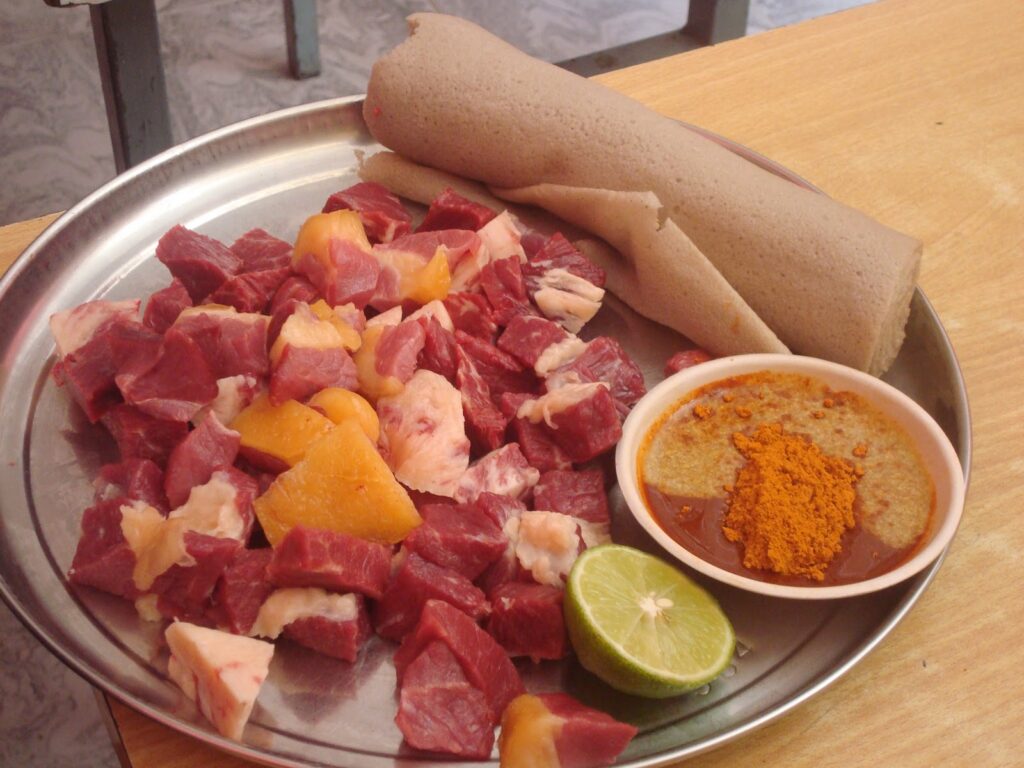
Ethiopian food has a unique and distinctive flavor profile that sets it apart from many other cuisines. Here’s a general description of how Ethiopian food tastes:
1. Spicy and aromatic: The liberal use of spice blends like berbere (a mixture of chili peppers, garlic, ginger, and other spices) gives many Ethiopian dishes a warm, spicy, and fragrant flavor. The blend of spices creates complex and layered flavors.
2. Rich and savory: While many Ethiopian dishes are vegetarian, they still have a rich, savory taste due to the slow-cooking methods and the use of ingredients like onions, garlic, tomatoes, and spiced clarified butter (niter kibbeh).
3. Tangy and slightly sour: The injera bread, made from fermented teff flour, has a slightly tangy and sour taste that complements the rich stews and vegetable dishes.
4. Earthy and nutty: Ingredients like lentils, chickpeas, and teff grain contribute an earthy, nutty flavor to many Ethiopian dishes.
5. Herbaceous: Dishes often incorporate fresh herbs like green chilies, ginger, and garlic, adding brightness and herbaceous notes.
6. Varied textures: Ethiopian cuisine features a variety of textures, from the spongy injera bread to the smooth lentil stews, chunky vegetable dishes, and tender slow-cooked meats (for non-vegetarian dishes).
7. Unique flavors: Some dishes incorporate ingredients like awaze (a mustard-based condiment) or tej (a honey wine), adding distinct flavors not commonly found in other cuisines.
Overall, Ethiopian food is characterized by a complex interplay of spicy, savory, tangy, and earthy flavors, with layers of aromatic spices and herbs. The flavors are bold and distinctive, yet well-balanced and harmonious.
Different types of Ethiopian Food are as Follows
Here are some more details about the flavors and tastes of Ethiopian Food:
Injera Bread:
The injera bread, made from fermented teff flour, has a slightly spongy texture and a subtle sour taste that complements the dishes. The fermentation process gives it a tangy, almost sourdough-like flavor.
Wot Stews:
The wot or wat stews are a staple of Ethiopian cuisine. These slow-cooked stews can be made with lentils, beans, vegetables or meat. They have a rich, almost buttery taste from the niter kibbeh (spiced clarified butter) and a warm, complex spice flavor from the berbere seasoning blend.
Tibs:
Tibs are sautéed or stir-fried dishes, often made with meat, onions, and green peppers. They have a smoky, slightly charred flavor from the cooking process.
Kitfo:
Kitfo is a dish of minced raw beef, highly spiced with chili powder and niter kibbeh. It has a distinctly rich, beefy taste with a punch of heat from the chili.
Vegetable Dishes:
Ethiopian vegetable dishes like gomen (collard greens), atkilt (cabbage and potato) and buticha (chickpea stew) showcase the earthy, fresh flavors of the vegetables enhanced by aromatic spices.
Sambusas:
These small stuffed pastries, similar to samosas, can have savory fillings like lentils or meat. They provide a contrast of crispy outer pastry and savory, sometimes spicy, filling.
Overall, the layering of flavors from the spice blends, the use of fermented and clarified butter, the balance of earthy, tangy and rich tastes create a distinctive Ethiopian flavor profile unlike any other cuisine.





